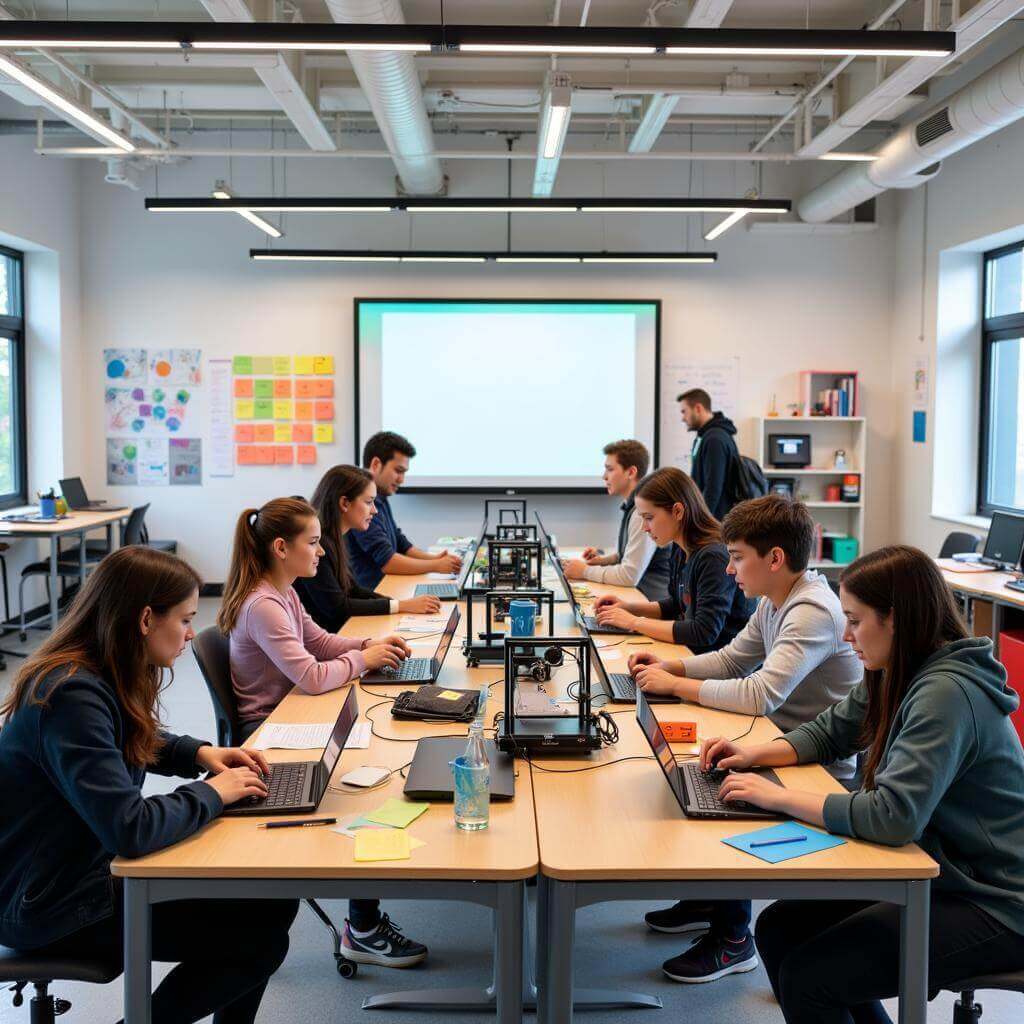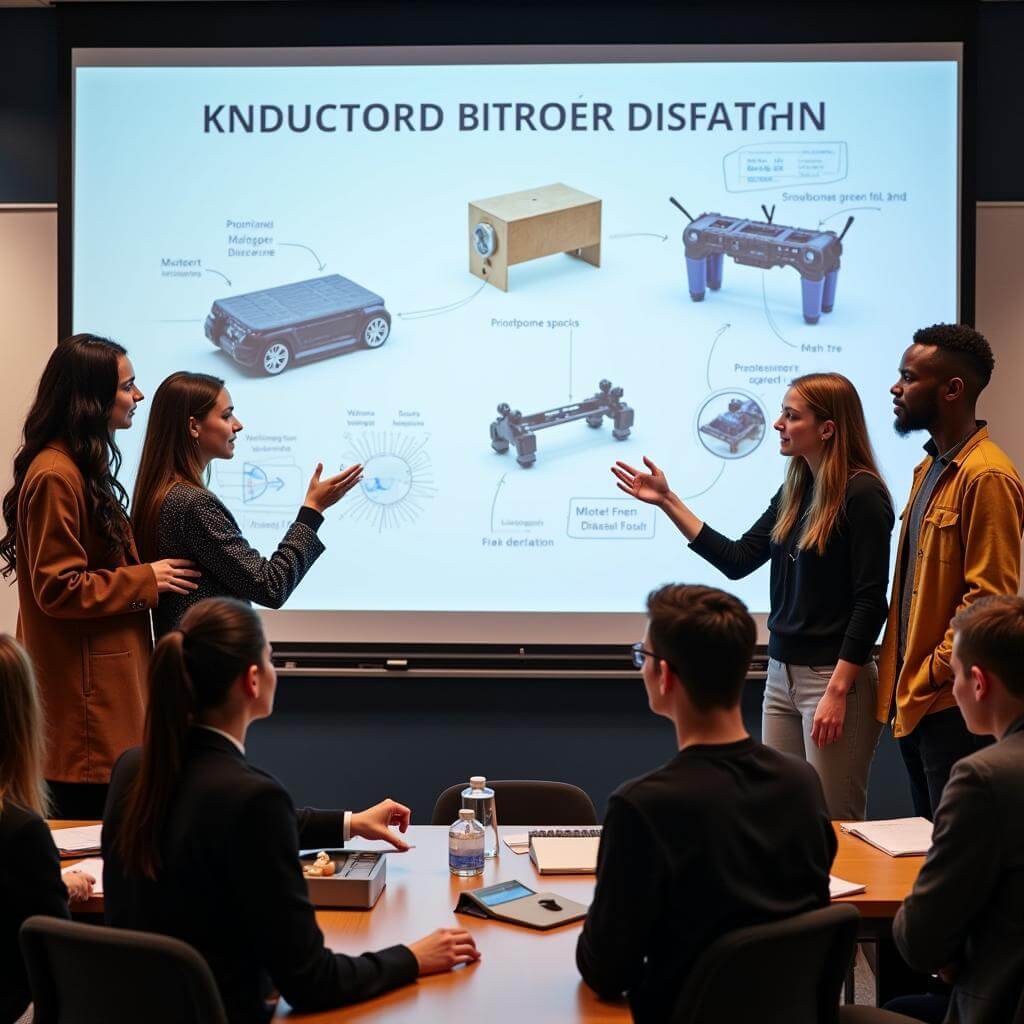Passage 1: The Rise of Student-Led Innovation Labs
In recent years, universities across the globe have witnessed a remarkable phenomenon: the emergence and rapid proliferation of student-led innovation labs. These dynamic spaces, often nestled within the heart of campus life, are revolutionizing the way students approach problem-solving, entrepreneurship, and technological advancement. Unlike traditional classrooms or research facilities, these labs provide a unique environment where students from diverse disciplines can collaborate, experiment, and bring their innovative ideas to life.
The concept of student-led innovation labs first gained traction in the early 2000s, primarily in prestigious institutions such as MIT and Stanford. However, what began as a niche experiment has now blossomed into a global movement, with hundreds of universities worldwide adopting this model. These labs serve as incubators for creativity, offering students access to cutting-edge technology, mentorship from industry experts, and the freedom to pursue projects that often transcend academic boundaries.
One of the key factors driving the success of these labs is their inherent interdisciplinary nature. In a typical innovation lab, one might find engineering students working alongside artists, business majors collaborating with computer scientists, and social science students partnering with budding entrepreneurs. This cross-pollination of ideas and expertise often leads to breakthrough innovations that would be unlikely to emerge from more siloed academic environments.
Moreover, these labs are playing a crucial role in bridging the gap between academic theory and real-world application. Students are encouraged to tackle genuine problems faced by industries and communities, fostering a sense of social responsibility alongside their innovative spirit. Many projects initiated in these labs have gone on to become successful startups or have been adopted by established companies, demonstrating the tangible impact of student-led innovation.
The rise of these labs has not gone unnoticed by industry leaders and policymakers. Many corporations now view university innovation labs as fertile ground for recruiting top talent and sourcing fresh ideas. Governments, too, are recognizing the potential of these labs to drive economic growth and solve pressing societal challenges. As a result, there’s been an increase in funding and support for these initiatives, further fueling their expansion and impact.
 Students collaborating in an innovation lab
Students collaborating in an innovation lab
However, the journey hasn’t been without challenges. Many universities struggle with integrating these labs into their existing academic structures and curricula. Questions about academic credit, intellectual property rights, and the balance between guided learning and free exploration continue to be debated. Additionally, ensuring equal access and diversity within these labs remains an ongoing concern, as there’s a risk of these spaces becoming exclusive enclaves for a select few.
Despite these challenges, the trajectory of student-led innovation labs appears to be on an upward trend. As technology continues to evolve at a breakneck pace and global challenges become increasingly complex, the need for innovative, multidisciplinary approaches to problem-solving has never been greater. These labs, with their unique blend of youthful energy, diverse perspectives, and cutting-edge resources, are well-positioned to play a pivotal role in shaping the future of innovation and entrepreneurship.
As we look to the future, it’s clear that student-led innovation labs are more than just a passing trend. They represent a fundamental shift in how we approach education, innovation, and the cultivation of future leaders. By empowering students to take the reins of their learning and creative pursuits, these labs are not just fostering innovation – they’re nurturing a new generation of thinkers, doers, and problem-solvers ready to tackle the challenges of tomorrow.
Questions 1-7
Do the following statements agree with the information given in the Reading Passage?
Write
TRUE if the statement agrees with the information
FALSE if the statement contradicts the information
NOT GIVEN if there is no information on this
- Student-led innovation labs first appeared in universities outside the United States.
- These labs encourage collaboration between students from different academic disciplines.
- All projects started in student-led innovation labs become successful startups.
- Corporate leaders are interested in the talent emerging from university innovation labs.
- Governments have reduced funding for student-led innovation initiatives in recent years.
- Integrating innovation labs into existing university structures has been challenging.
- Student-led innovation labs are expected to decrease in popularity in the coming years.
Questions 8-13
Complete the sentences below.
Choose NO MORE THAN TWO WORDS from the passage for each answer.
- Student-led innovation labs provide students with access to ___ and mentorship from experts in various fields.
- The ___ nature of these labs leads to innovative ideas that might not emerge in traditional academic settings.
- These labs help bridge the gap between academic theory and ___.
- Many corporations view university innovation labs as a source of ___ and fresh ideas.
- There are ongoing debates about ___ rights in relation to projects developed in these labs.
- Ensuring ___ within these labs remains a concern to prevent them from becoming exclusive spaces.
Passage 2: Challenges and Opportunities in Student Innovation
The landscape of higher education is undergoing a profound transformation, driven in large part by the burgeoning movement of student-led innovation. This shift is not merely a superficial change in how universities operate; rather, it represents a fundamental reimagining of the role of students in the academic ecosystem. As these innovation hubs proliferate across campuses worldwide, they bring with them a host of challenges and opportunities that are reshaping the very fabric of educational institutions.
One of the most significant challenges faced by universities in implementing student-led innovation labs is the integration of these unconventional spaces into traditional academic structures. The free-form, project-based nature of these labs often clashes with the rigid, credit-hour system that has long been the backbone of higher education. Administrators and faculty members grapple with questions of how to assess and accredit the work done in these labs, which often defies conventional grading metrics. Moreover, the interdisciplinary nature of many innovation projects can make it difficult to determine which department should oversee or fund them.
Another pressing concern is the issue of intellectual property rights. As students develop potentially valuable innovations within university-provided facilities and under the guidance of faculty mentors, questions arise about who owns the rights to these creations. This dilemma is further complicated when projects involve collaboration with industry partners or receive external funding. Striking a balance between protecting the university’s interests, rewarding student innovators, and maintaining an open, collaborative environment is a delicate and ongoing challenge.
 Student innovators presenting their project
Student innovators presenting their project
Ensuring equitable access to these innovation spaces is another hurdle that universities must overcome. There’s a risk that these labs could become exclusive enclaves, accessible only to a select group of students who are already well-connected or academically advanced. This potential for exclusivity runs counter to the principles of diversity and inclusion that many institutions strive to uphold. Universities must work diligently to create pathways for a wide range of students to participate in and benefit from these innovation initiatives.
Despite these challenges, the opportunities presented by student-led innovation labs are immense and multifaceted. Perhaps most importantly, these labs provide a unique environment for students to develop crucial skills that are highly valued in the modern workforce. Beyond technical expertise, students cultivate abilities in problem-solving, teamwork, and entrepreneurial thinking – competencies that are often cited by employers as being in short supply among recent graduates.
Furthermore, these labs serve as powerful catalysts for interdisciplinary collaboration. By bringing together students from diverse academic backgrounds, they foster a cross-pollination of ideas that can lead to truly innovative solutions. This interdisciplinary approach not only enhances the quality of the innovations produced but also prepares students for the increasingly collaborative nature of professional work environments.
The impact of student-led innovation extends beyond the campus boundaries. Many of the projects developed in these labs address real-world problems, from local community issues to global challenges. This focus on practical application not only enhances the relevance of students’ education but also positions universities as active contributors to societal progress and economic development.
Moreover, these innovation hubs are proving to be valuable assets in attracting and retaining top talent – both students and faculty. For students, the opportunity to engage in cutting-edge, hands-on projects can be a significant factor in choosing where to pursue their education. For faculty, these labs provide exciting opportunities for research, mentorship, and staying connected with the latest trends in their fields.
The rise of student-led innovation is also reshaping the relationship between universities and industry. Many companies are increasingly viewing these labs as sources of fresh ideas and potential future employees. This has led to growing partnerships between academia and industry, with companies providing funding, mentorship, and real-world projects for students to tackle. These collaborations not only enhance the educational experience but also help ensure that academic innovation remains relevant to market needs.
As we look to the future, it’s clear that student-led innovation labs will play an increasingly central role in higher education. The challenges they present – from structural integration to equity concerns – are not insurmountable obstacles but rather opportunities for universities to evolve and adapt. By embracing this movement, institutions have the chance to not only enhance the educational experience they offer but also to position themselves at the forefront of innovation and societal impact.
The rise of student-led innovation represents a paradigm shift in how we approach education and prepare the next generation of leaders and innovators. As these labs continue to evolve and proliferate, they hold the promise of transforming not just individual campuses, but the entire landscape of higher education and its role in driving progress and change in the world.
Questions 14-19
Choose the correct letter, A, B, C, or D.
-
According to the passage, one of the main challenges in implementing student-led innovation labs is:
A) Lack of student interest
B) Insufficient funding
C) Integration into traditional academic structures
D) Resistance from faculty members -
The issue of intellectual property rights in student-led innovation labs is complicated by:
A) Students’ lack of understanding of legal matters
B) Collaboration with industry partners and external funding
C) Universities’ reluctance to share profits
D) Government regulations on academic innovations -
The passage suggests that to ensure equitable access to innovation labs, universities should:
A) Limit participation to top-performing students
B) Charge additional fees for lab access
C) Create pathways for a diverse range of students to participate
D) Focus solely on STEM students -
According to the text, student-led innovation labs help develop skills that are:
A) Only relevant in academic settings
B) Highly valued in the modern workforce
C) Outdated in today’s job market
D) Easily taught in traditional classrooms -
The relationship between universities and industry is being reshaped by student-led innovation labs because:
A) Companies are providing less funding to universities
B) Universities are competing with industry for innovations
C) Industry is viewing these labs as sources of ideas and talent
D) Students are less interested in traditional career paths -
The author’s overall view of student-led innovation labs is that they:
A) Are a temporary trend in higher education
B) Pose more challenges than opportunities for universities
C) Will play an increasingly important role in higher education
D) Should be limited to a few elite institutions
Questions 20-26
Complete the summary below.
Choose NO MORE THAN TWO WORDS from the passage for each answer.
Student-led innovation labs are transforming higher education, but they come with challenges. Integrating these labs into 20) academic structures is difficult, as their project-based nature doesn’t fit easily into traditional systems. The issue of 21) rights is complex, especially when projects involve industry collaboration. Ensuring 22)___ to these labs is crucial to avoid creating exclusive spaces.
Despite these challenges, the labs offer significant opportunities. They help students develop 23) that are valuable in the modern workforce. The labs foster 24) collaboration, leading to innovative solutions. Many projects address 25), enhancing the relevance of education. These innovation hubs are also reshaping university-industry relationships, with companies viewing them as sources of 26) and potential employees.
Passage 3: The Global Impact of Student Innovation
The proliferation of student-led innovation labs across universities worldwide has catalyzed a seismic shift in the global innovation landscape. These dynamic hubs of creativity and entrepreneurship are not merely transforming the educational experience; they are reshaping industries, influencing policy decisions, and addressing some of the most pressing challenges facing our planet. As we delve deeper into this phenomenon, it becomes evident that the impact of student innovation extends far beyond campus boundaries, touching virtually every sector of society and economy.
One of the most profound effects of this movement has been the democratization of innovation. Historically, groundbreaking innovations were often the province of well-funded research institutions or corporate R&D departments. However, student-led innovation labs have leveled the playing field, providing resources and platforms for young minds from diverse backgrounds to bring their ideas to fruition. This democratization has led to a surge in innovations that address niche problems or underserved markets, which might have been overlooked by traditional innovation powerhouses.
The global nature of this movement has also fostered unprecedented levels of international collaboration among students. Virtual platforms and exchange programs have enabled innovators from different corners of the world to pool their knowledge and resources, tackling global challenges with a truly multinational perspective. This cross-pollination of ideas across cultural and geographical boundaries has resulted in solutions that are more adaptable and applicable on a global scale.
 Global network of student innovators
Global network of student innovators
In the realm of sustainability and climate change, student innovators have emerged as powerful agents of change. Many student-led projects focus on developing clean technologies, sustainable urban solutions, and innovative approaches to resource management. For instance, a team of engineering students from a university in India recently developed a low-cost, solar-powered water purification system that has been deployed in several rural communities, providing clean drinking water to thousands. Such innovations not only address immediate needs but also contribute to long-term sustainability goals.
The healthcare sector has been another significant beneficiary of student-led innovation. From developing affordable medical devices for low-resource settings to creating AI-powered diagnostic tools, student innovators are at the forefront of improving global health outcomes. A notable example is a group of bioengineering students from a U.S. university who created a portable, smartphone-based device for early detection of cervical cancer, which has the potential to save countless lives in regions with limited access to advanced medical facilities.
In the domain of digital technology and artificial intelligence, student innovators are pushing the boundaries of what’s possible. They are developing cutting-edge applications in areas such as natural language processing, computer vision, and machine learning. These innovations are not only advancing the field of AI but are also finding practical applications in various industries, from enhancing educational tools to improving financial services in developing countries.
The impact of student innovation on the business world has been equally profound. Many successful startups that have disrupted traditional industries trace their origins to university innovation labs. These student-led ventures often bring fresh perspectives and novel approaches to longstanding problems, challenging established players and driving industry-wide innovation. Moreover, the entrepreneurial skills honed in these labs are creating a new generation of business leaders who are more adaptable, tech-savvy, and socially conscious.
Another significant aspect of the global impact of student innovation is its influence on policy-making and governance. As student innovators tackle complex societal issues, their work often highlights gaps in current policies or demonstrates the potential of new approaches. This has led to increased engagement between student innovators and policymakers, with some governments actively seeking input from university innovation labs in shaping policies related to technology, environment, and social welfare.
The ripple effects of student-led innovation are also being felt in the realm of education itself. The success of these labs has prompted a reevaluation of traditional educational models, pushing universities to incorporate more hands-on, project-based learning experiences into their curricula. This shift is preparing students not just with theoretical knowledge but with practical skills and experiences that are crucial in the rapidly evolving job market.
Furthermore, the global network of student innovators is fostering a new kind of diplomacy – one based on shared challenges and collaborative problem-solving. As students from different countries work together on innovation projects, they build lasting relationships and develop a deeper understanding of diverse cultures and perspectives. This “innovation diplomacy” has the potential to promote international cooperation and understanding in ways that traditional diplomatic channels might not achieve.
However, it’s important to acknowledge that the global impact of student innovation also raises certain challenges and ethical considerations. As student-led innovations increasingly affect various aspects of society, questions arise about accountability, safety standards, and the long-term implications of rapidly deployed technologies. There’s a growing need for ethical frameworks and governance structures to ensure that these innovations are developed and implemented responsibly.
In conclusion, the global impact of student-led innovation is multifaceted and far-reaching. From driving technological advancements and addressing global challenges to reshaping industries and influencing policy, student innovators are playing a crucial role in shaping our collective future. As this movement continues to evolve and expand, it holds the promise of not only generating groundbreaking solutions but also fostering a more collaborative, innovative, and socially conscious global community. The rise of student-led innovation labs may well be remembered as one of the most significant developments in the history of education and innovation, with repercussions that will be felt for generations to come.


